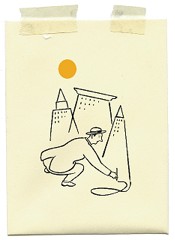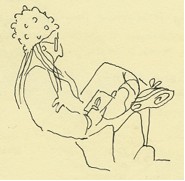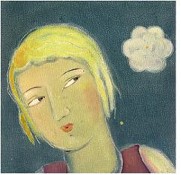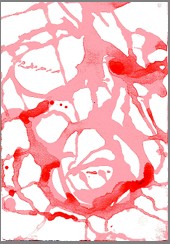I met a man the other day who recently lost his job. And yes, it was directly related to the tsunami of a financial crisis that began last year and keeps on going. He's a highly educated computer scientist, no slouch, and he's scared. There aren't all that many jobs like the one he had for people with his level of expertise right now, so he can't see the way forward. He's finding it a little hard to even think there is a way forward. His predicament made me think. Because I'm an artist, I'm used to living more or less comfortably on the edge of uncertainty. Making art teaches us to envision possibility and to have faith, even when the outcome isn't fully known.
Most of us want positive change for ourselves and for our planet but many of us also feel stuck. Lots of us feel afraid. How can we create the life we want? How can we change our world? When we move from a problem to a solution in art, we often take a quantum creative leap. At one moment, we're facing the unknown, then, suddenly, we're in a whole new place without having taken every plodding step in between. Sometimes we aren't stepping forward but sideways. It might just be that to solve global challenges and personal ones too, we need to get our creative spark back again so we can make those leaps.
 As a teacher, I've discovered something else. The simple act of drawing can spark us, whether or not we're artists. Lots of people say they can't draw but this is a myth -- no special talent is necessary. When we were two and someone gave us crayons, we didn't hesitate to dive in. If we've given up drawing, we can begin again.
As a teacher, I've discovered something else. The simple act of drawing can spark us, whether or not we're artists. Lots of people say they can't draw but this is a myth -- no special talent is necessary. When we were two and someone gave us crayons, we didn't hesitate to dive in. If we've given up drawing, we can begin again.
Here's how it works. Drawing, by its very nature, takes us out of our right brain, verbal, linear-thinking minds. Innovation is seldom the result of linear thinking -- it comes from the intersection of our individuality and the inspiration that comes to us. We need to elude our right brain so inspiration can find a way in. Drawing is one simple way to do this. It captures our full attention, almost effortlessly, even if we're just scribbling. It takes us to a place where habitual thoughts fall away, and feelings too. When new thoughts enter, we can see them more clearly and discern what has real value, then act.
But we can take it further. When I began to teach drawing to adults, I saw immediately the way many of my students panicked when we started new things. Of course, I was lobbing big challenges their way, like making drawings five feet tall when they had little, or no, prior experience. Or asking them to draw with their eyes closed or just scribble. Curiously, it was scribbling, the simplest form of drawing, that most flummoxed them. I introduced it when a student new to drawing expressed fear about drawing from life.
"Okay, let's begin by just scribbling." I thought I was making it easy for her but I found them all just staring at the blank paper in front of them.
"But how do we do this?" said one.
"Just lines and squiggles, smudges, anything! Like a two-year-old!"
They all frowned but finally began. We're all inhibited when we don't know the "right" way or when the results will be unpredictable. We've been judged and graded at our efforts on all fronts since our school days. Is it any wonder we've lost touch with a real sense of freedom and creative confidence? Or that we think the authority lies outside of ourselves? Often, we choose to do nothing rather than fail. It's easy to feel stuck.

So, to be truly creative, we need to let go of expectations and be open to possibility. Often when we "fail," we get to go somewhere new. In fact, this is the very essence of what creativity is--to make something new or to make new connections between knowledge that already exists. Drawing can teach us the fundamentals of creative thinking--how to be fully present in the moment, to let go of expectations, to see what emerges and to build on strengths. It's in the quiet moments, with our mind focused on our hand that inspiration darts in. It's always there for us but we're often so busy and so attached to old ideas that we don't see it. To create with ease, we need to follow inspiration without hesitation. It may well take us where we've never gone before. It will ask us to have courage and assure us that this will grow with practice. What we discover in drawing is what we can bring back into our lives.
We can actually make drawing a regular practice, like yoga or meditation. It can be something we do in the midst of our day, for fifteen minutes or half an hour, to connect again with a place of focus and peace. It can be the pause that refreshes and we can use it to find our creative spark again. We'll improve our drawing skills, of course. Practice does make perfect. But, more importantly, we'll get ideas. When we sit down to draw, we don't need to be "good." Drawing is a humble, even primal, art. It can just be fun. One drawing, one shift in mood, one opening in our minds -- who knows where it goes?
For all the problems multiplying in our world at present, artists are curiously multiplying too. Perhaps when the need is great, the urge to create something, anything, positive is also great. In Boston, the city I live in, there are hundreds of artist studios in every corner of the city and its surrounding towns. Once, studios were just for professional artists. Now, a lot people are realizing there's an artist within each of us.
Whether we paint or make jewelry or create a community garden or organize a public school initiative, there are many ways to solve the problems that confront us and to offer up our creativity. Ex-Beatle, Paul McCartney, asked us at the beginning of this year to make Meatless Mondays to combat global warming. The methane released by cow manure is a key contributor to ozone depletion. We can all cut down on our meat consumption; it's a simple, brilliant idea.
 It hands the power back to us. We don't need to wait for politicians to make new laws. A couple of young guys here have started a business where they pick up recyclable plastics from corporations, for a price, of course. There's a business and a problem solved. A friend of mine is turning vinyl signage into wildly fashionable carry bags for us to take grocery shopping. There are two problems solved: the disposal of the vinyl signs and the elimination of the disposable bag when shopping.
It hands the power back to us. We don't need to wait for politicians to make new laws. A couple of young guys here have started a business where they pick up recyclable plastics from corporations, for a price, of course. There's a business and a problem solved. A friend of mine is turning vinyl signage into wildly fashionable carry bags for us to take grocery shopping. There are two problems solved: the disposal of the vinyl signs and the elimination of the disposable bag when shopping.
The man I met, who lost his job, will find a way forward though his future may be different than his past. Just as importantly we can radically change the way we've been doing business where only a few reap rich reward by envisioning new economic models. It's time for that change and many others. But first we need to understand and connect with our own creative energy and feel empowered again. As Gandhi said, "We need to be the change we want to see in the world."
The simple lesson of a drawing practice is that we're all creative. The happiness and confidence that we grow in ourselves does change the world. So, back to the drawing board!